U of U School of Medicine - Office of Diversity & Community Outreach
By: Mikio Moriyasu - Revised: 2006-08-03 devinIntroduction

In April 2002, the University of Utah School of Medicine's Office Diversity & Community Outreach sponsored a series of workshops for Native American high school students. One of these workshops required the use of our largest Mac teaching lab using Mac OS X.
Section Links
Setup and Preparation
In order to accommodate this specific workshop, thirty-two machines had to be upgraded to Mac OS X for the duration of the workshop and then immediately downgraded back to OS 9.2.2 for normal lab operations.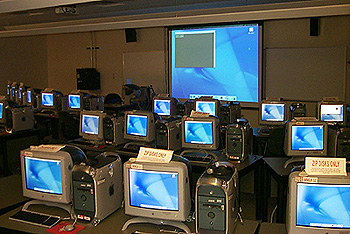
To do this, a Mac OS X Apple Software Restore (ASR) disk image with the specific application required for the workshop was first created using Disk Copy. This "OS X ASR Workshop" image was then transferred to a server. Because ASR runs only in Mac OS 9.x, we boot each Mac from a NetBoot disk that has a Mac OS 9 system folder. To help us streamline and automate this process, we used a task specific AppleScript in the "Startup Items" folder of our NetBoot HD image. This script detected each Mac's IP address, checked to see which disk image group the IP was in, and ran the appropriate ASR image, in this instance, the "Workshop" image. This process was then reversed to return the machines back to Mac OS 9.2.2. The entire upgrade/downgrade process took approximately 2 hours each way.
The Workshop
The workshop instructor, Research Assistant Professor Heidi Schubert, determines the three-dimensional structure of proteins using a technique called X-ray crystallography as part of her biochemistry research. She designed the workshop to introduced the students to the following concepts:- DNA and protein molecules have a three-dimensional shape.
- These 3-D shapes have recognizable defined structures.
- An examination of these structures can reveal information about the biochemistry of these molecules.
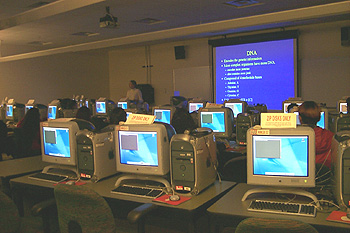
So that the students could rotate sample molecules in three-dimensions, zoom in on particular features, and view the molecule either as a general schematic or with all of the atoms present, Heidi needed to use a LINUX based application called "O".
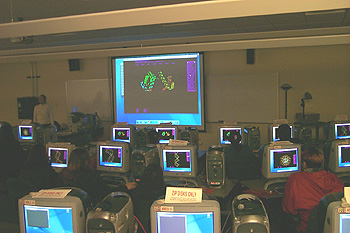
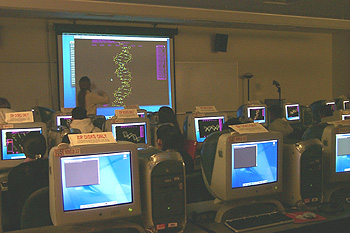
While other molecular visualization applications such as RasMol, PDBView, and PyMOL would allow the students to carry out the same functions, "O" had better graphics and had the ability to carry out predetermined commands.
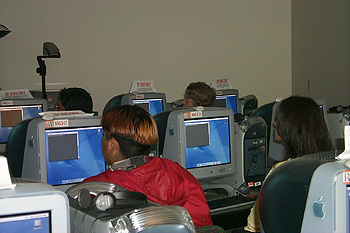
In this way, the students did not have to spend class time learning operational commands and could focus their complete attention for the entire workshop on the main topic.
Additional Information
For additional information regarding the following items, please select the appropriate link:Imaging Mac OS X with ASR & NetBoot
- www.macosxlabs.org (link dead)
- School of Medicine
- School of Medicine -- Office of Diversity and Community Outreach
- Department of Biochemistry
- "O" Crystallographic Modelling Tool
- RasMol Molecular Visualization Freeware
- PyMOL Molecular Visualization System
- PDBView -- Portable Database Viewer (link dead)
- Documentation
- Administration
- Authentication
- General Software
- Hardware
- Miscellaneous
- Multimedia
- Networking
- Operating Systems
- Outside Presentations
- Programming & Scripting
- Security
- Servers
- Short Courses
- System Deployment
- System Utilities
- What's New

